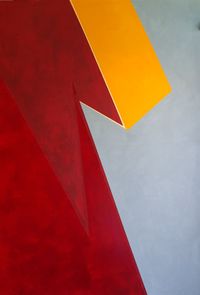Ludwig von Wittgenstein : Tractatus Logico Philosophicus
140x100 cm 2018 oil on paper
1.21 Quelque chose peut isolément avoir lieu ou ne pas avoir lieu, et tout le reste demeurer inchangé.
1.21 Iets kan het geval zijn of niet het geval zijn, en al het andere kan gelijk blijven.
1.21 Any one can either be the case or not be the case, and everything else remains the same.
1.21 Eines kann der Fall sein oder nicht der Fall sein und alles übrige gleich bleiben.
140x100 cm 2018 oil on paper
3.326 - Pour reconnaître le symbole sous le signe, il faut prendre garde à son usage pourvu de sens.
3.326 - Om het symbool door het teken te herkennen, moet men op het betekenisvolle gebruik letten.
3.326 - In order to recognize the symbol in the sign we must consider the significant use.
3.326 - Um das Symbol am Zeichen zu erkennen, muss man auf den
sinnvollen Gebrauch achten.
100x140 cm 2019 oil on paper
3.142 Seuls des faits peuvent exprimer un sens, une classe de noms ne le peut pas.
3.142 Slechts feiten kunnen een betekenis uitdrukken, een verzameling van namen kan dat niet.
3.142 Only facts can express a sense, a class of names cannot.
3.142 Nur Tatsachen können einen Sinn ausdrücken, eine Klasse von Namen kann es nicht.
140x100 cm 2019 oil on paper
4.41 - Les possibilités de vérité des propositions élémentaires sont les conditions de la vérité et de la fausseté des propositions.
4.41 De waarheidsmogelijkheden van de elementaire proposities zijn de voorwaarden van de waarheid en onwaarheid van de proposities.
4.41 The truth-possibilities of the elementary propositions are the conditions of the truth and falsehood of the propositions.
4.41 Die Wahrheitsmöglichkeiten der Elementarsätze sind die Bedingungen der Wahrheit und Falschheit der Sätze.
140x100 cm 2017 oil on paper
2.063 La totalité de la réalité est le monde.
2.063 De totale werkelijkheid is de wereld.
2.063 The total reality is the world.
2.063 Die gesamte Wirklichkeit ist die Welt.
140x100 cm 2018 oil on paper
6.21 La proposition de la mathématique n'exprime aucune pensée.
6.21 De stelling in de wiskunde drukt geen gedachte uit.
6.21 Mathematical propositions express no thoughts.
6.21 Der Satz der Mathematik drückt keinen Gedanken aus.
70x200cm 2018 oil on paper
5.641 - Il Y a donc réellement un sens selon lequel il peut être question en philosophie d'un je, non psychologiquement. Le je fait son entrée dans la philosophie grâce à ceci : que « le monde est mon monde » . Le je philosophique n'est ni l'être humain, ni le corps humain, ni l'âme humaine dont s'occupe la psychologie, mais c'est le sujet métaphysique, qui est frontière - et non partie - du monde.
5.641 Er bestaat dus werkelijk een betekenis waarin de filosofie op een niet-psychologische manier sprake kan zijn van het Ik. Het Ik treedt op in de filosofie doordat “ de wereld mijn wereld is”. Het filosofische Ik is niet de mens, maar het menselijk lichaam, of de menselijke ziel waar de psychologie over gaat, maar het metafysische subject, de grens van de wereld, niet een deel ervan.
5.641 There is therefore really a sense in which in philosophy we can talk of a non-psychological I. The I occurs in philosophy through the fact that the “world is my world”. The philosophical I is not the man, not the human body or the human soul of which psychology treats, but the metaphysical subject, the limit—not a part of the world.
5.641 Es gibt also wirklich einen Sinn, in welchem in der Philosophie nicht-psychologisch vom Ich die Rede sein kann. Das Ich tritt in die Philosophie dadurch ein, dass die „Welt meine Welt ist“. Das philosophische Ich ist nicht der Mensch, nicht der menschliche Körper, oder die menschliche Seele, von der die Psychologie handelt, sondern das metaphysische Subjekt, die Grenze—nicht ein Teil der Welt.
100x140 cm 2019 oil on paper
5.5321 - Au lieu de « (x) : fx ⊃ X = a », nous écrivons donc par exemple “(∃x).fx. ⊃ .f a : ∼(∃x, y) . fx . fy. Et la proposition : « Il y a seulement un x qui satisfait f ( ) » se formule : “(∃x) . fx : ∼(∃x, y) . fx . fy”.
5.5321 In plaats van “(x) : fx ⊃ x = a” schrijven we dus bijv. “(∃x).fx. ⊃ .f a : ∼(∃x, y) . fx . fy”. En de volzin ‘slechts een x voldoet aan de functie f()” luidt: “(∃x) . fx : ∼(∃x, y) . fx . fy”.
5.5321 Instead of “(x) : fx ⊃ x = a” we therefore write e.g. “(∃x).fx. ⊃ .f a : ∼(∃x, y) . fx . fy”. And the proposition “only one x satisfies f()” reads: “(∃x) . fx : ∼(∃x, y) . fx . fy”.
5.5321 Statt „(x) : fx ⊃ x = a“ schreiben wir also z. B. „(∃x) . fx. ⊃ .f a : ∼(∃x, y) . fx . fy“. Und der Satz „n u r Ein x befriedigt f()“ lautet: „(∃x). fx : ∼(∃x, y) . fx . fy“.
140x100 cm 2018 oil on paper
2.225 Il n'y a pas d'image vraie a priori.
2.225 Een a priori beeld bestaat niet.
2.225 There is no picture which is a priori true.
2.225 Ein a priori wahres Bild gibt es nicht.
140x100 cm 2018 oil on paper
6.363 La procédure de l'induction consiste en ceci que nous adoptons la loi la plus simple qui puisse être mise en accord avec nos expériences.
6.363 Het proces van de inductie bestaat daarin, dat wij de eenvoudigste wet aannemen, die met onze ervaringen in overeenstemming te brengen is.
6.363 The process of induction is the process of assuming the simplest law that can be made to harmonize with our experience.
6.363 Der Vorgang der Induktion besteht darin, dass wir das ein- fachste Gesetz annehmen, das mit unseren Erfahrungen in Einklang zu bringen ist.









